How to Integrate Spreed Me WebRTC with NextCloud
Spreed ME WebRTC aims to bring private text, audio/video chat back to people. It’s like a free open source and self-hosted alternative to Google Hangouts. In previous tutorials, we discussed how to install Spreed WebRTC using Docker image. This tutorial is going to show you how to integrate Spreed WebRTC with NextCloud.
To follow this tutorial, it is assumed that you have already set up a NextCloud server with HTTPS enabled and you have followed our previous tutorials on installing Spreed WebRTC.
Once you finish this tutorial, you will have the ability to:
- Start private text, audio/video chat with NextCloud users or non-NextCloud users from NextCloud installation.
- Share files from NextCloud or save shared files to NextCloud.
- Share your computer screen or YouTube video.
So without further ado, let’s get started.
Same Origin
To use the screensharing feature, we need to let Spreed and NextCloud run on the same origin. Same origin means that Spreed and Nextcloud can be accessed using the same protocol scheme, the same domain name and the same port number.
So if your Nextcloud installation is accessed via
https://nextcloud.your-domain.com
Then you can put Spreed WebRTC on a sub-directory of your NextCloud installation.
https://nextcloud.your-domain.com/webrtc
So that they are of the same origin.
Changing basePath
To let Spreed WebRTC know that it will be accessed via /webrtc sub-directory, we need to edit the server.conf file.
sudo nano /etc/spreed/server.conf
Find the following line.
;basePath = /some/sub/path/
Change it to
basePath = /webrtc
Save and close the file. Then restart Spreed WebRTC server for the changes to take effect.
If you installed Spreed on Ubuntu 16.04 from official PPA, then restart it with:
sudo systemctl restart spreed-webrtc
If you installed Spreed using docker image, then restart the docker container with:
sudo docker restart my-spreed-webrtc
Setting up Reverse Proxy
To put Spreed WebRTC on a sub-directory of NextCloud installation, we need to set up a reverse proxy. We can use either Apache or Nginx. First, let’s see how to do it with Apache.
Apache Reverse Proxy Config
Open the https version of NextCloud virtual host file.
sudo nano /etc/apache2/sites-available/nextcloud-ssl.conf
Then put the following lines above </VirtualHost>.
<Location /webrtc> ProxyPass http://127.0.0.1:8080/webrtc ProxyPassReverse /webrtc </Location> <Location /webrtc/ws> ProxyPass ws://127.0.0.1:8080/webrtc/ws </Location> ProxyVia On ProxyPreserveHost On RequestHeader set X-Forwarded-Proto 'https' env=HTTPS
Save and close the file. Then run the following command to enable some Apache modules to make proxy work.
sudo a2enmod proxy proxy_http proxy_wstunnel headers
Reload Apache for the changes to take effect.
sudo systemctl reload apache2
Now you should be able to access Spreed WebRTC from the /webrtc sub-directory of your NextCloud installation. When your browser asks to access your camera, click Allow.
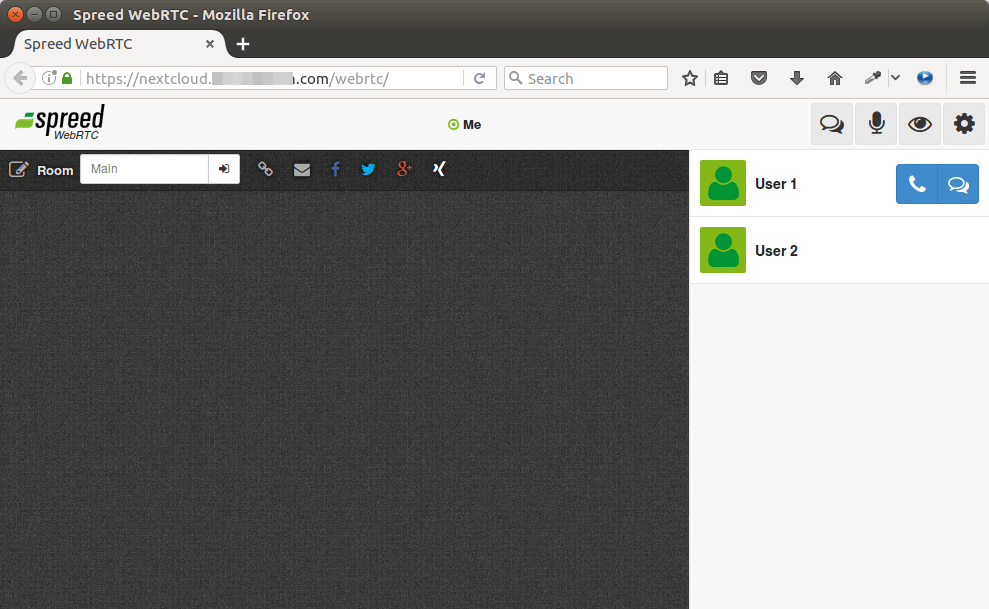
Nginx Reverse Proxy Config
Open your NextCloud server block file.
sudo nano /etc/nginx/conf.d/nextcloud.conf
Put the following lines under the https server context.
location ^~ /webrtc {
proxy_pass http://127.0.0.1:8080;
proxy_http_version 1.1;
proxy_set_header Upgrade $http_upgrade;
proxy_set_header Connection "upgrade";
proxy_set_header X-Forwarded-Proto $scheme;
proxy_set_header Host $http_host;
proxy_set_header X-Real-IP $remote_addr;
proxy_set_header X-Forwarded-For $proxy_add_x_forwarded_for;
proxy_buffering on;
proxy_ignore_client_abort off;
proxy_redirect off;
proxy_connect_timeout 90;
proxy_send_timeout 90;
proxy_read_timeout 90;
proxy_buffer_size 4k;
proxy_buffers 4 32k;
proxy_busy_buffers_size 64k;
proxy_temp_file_write_size 64k;
proxy_next_upstream error timeout invalid_header http_502 http_503 http_504;
}
Save and close the file. Then test Nginx configuration and reload.
sudo nginx -t sudo systemctl reload nginx
Now you should be able to access Spreed WebRTC from the /webrtc sub-directory of your NextCloud installation. When your browser asks to access your camera, click Allow.

Installing the Spreed ME NextCloud App
Go to NextCloud App store.

Then click Tools tab on the left. Find Spreed.ME app. Click Enable button.
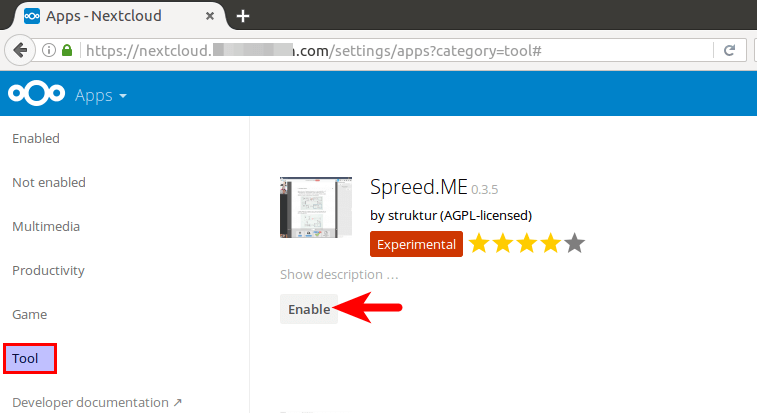
Next, go to Nextcloud admin page, click Additional settings and scroll down to bottom of the page. Once you see the Spreed.ME section, click Generate Spreed WebRTC config button.

Now copy the Spreed WebRTC config generated by Spreed.ME app and don’t forget to click Save Settings.
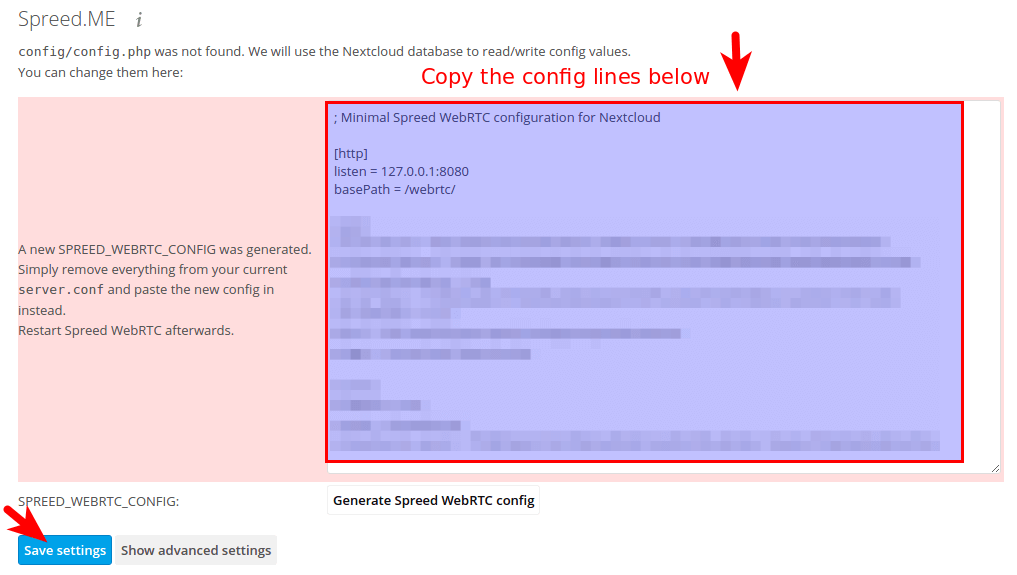
Then rename /etc/spreed/server.conf to /etc/spreed/server.conf.bak.
sudo mv /etc/spreed/server.conf /etc/spreed/server.conf.bak
Create a new server.conf file.
sudo nano /etc/spreed/server.conf
And paste the Spreed WebRTC config into the file. Save and close the file. Restart Spreed WebRTC server.
sudo systemctl restart spreed-webrtc
If you are running Spreed WebRTC using Docker image, first you need to comment out the listen = 127.0.0.1:8080 line in server.conf by adding a semicolon.
; listen = 127.0.0.1:8080
Then you should stop and remove the existing Spreed WebRTC container.
sudo docker stop my-spreed-webrtc sudo docker rm my-spreed-webrtc
Next you need to start a new Spreed WebRTC container and also mount /var/www/nextcloud/apps/spreedme/extra/ to the container. Replace /var/www/nextcloud with your own NextCloud webroot path.
sudo docker run -d --name my-spreed-webrtc -p 8080:8080 -p 8443:8443 -v /etc/spreed:/etc/spreed -v /var/log/spreed:/var/log/spreed -v /var/www/nextcloud/apps/spreedme/extra:/var/www/nextcloud/apps/spreedme/extra -i -t spreed/webrtc -c /etc/spreed/server.conf
Accessing Spreed ME via NextCloud
Once the above is done, go to the Speed.ME app from NextCloud web interface.
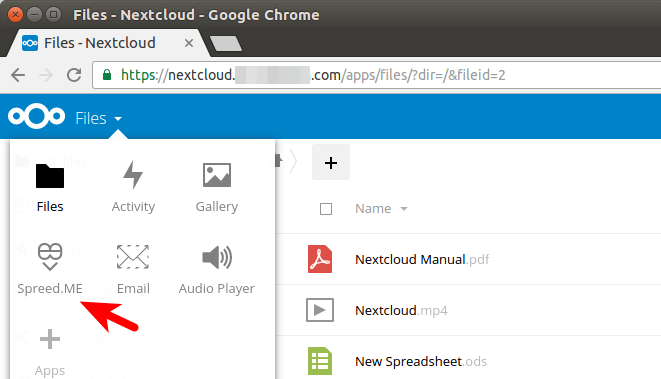
And now you can access Spreed ME chat room right from NextCloud installation.
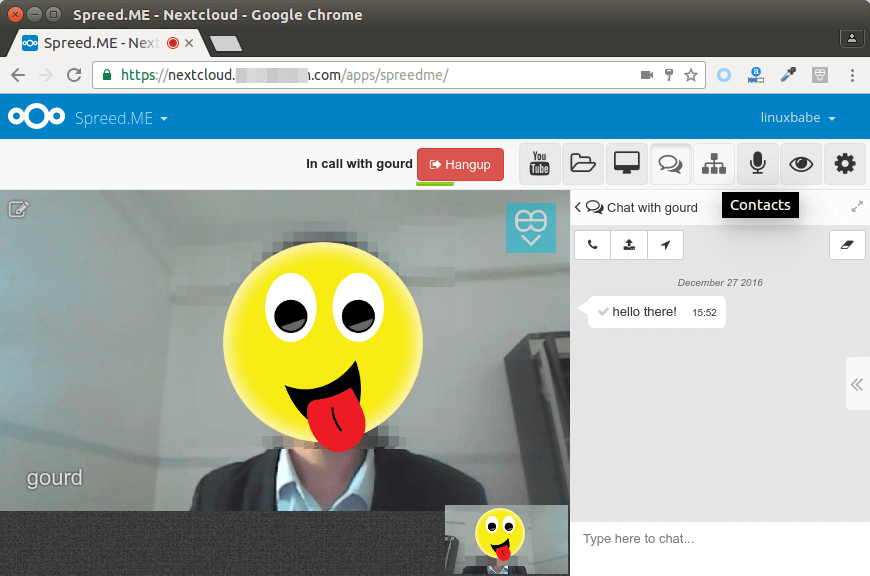
To invite non-Nextcloud user to join room chat, first you need to enable temporary password by going to Nextcloud admin page > Additional settings > Spree.ME > Advanced settings. Then check OWNCLOUD_TEMPORARY_PASSWORD_LOGIN_ENABLED. Save your settings.
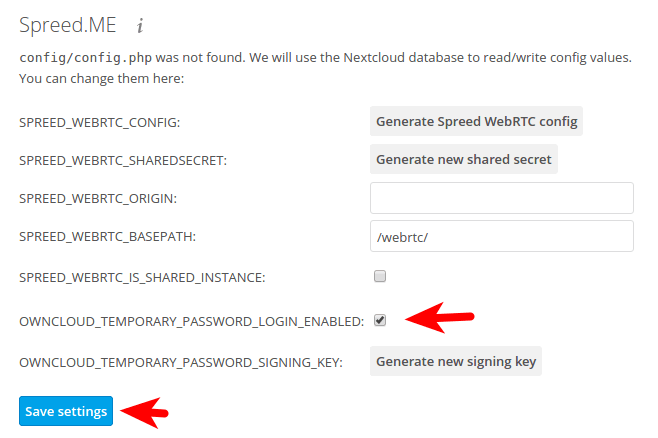
Now a key icon will appear next to Spreed.ME chat room which allows you to generate temporary password.

Note: NextCloud 11 introduced another app called Spreed Video Calls, which allows Nextcloud users to make video call. This is different from the Spreed ME app.
That’s it!
I hope this tutorial helped you integrate Spreed ME WebRTC with NextCloud. As always, if you found this post useful, then subscribe to our free newsletter. You can also follow us on Google+, Twitter or like our Facebook page.



Thank you for this very good tutorial. Worked for me. I just added –restart always in the docker image. One thing I cannot do though is receive a file. I can receive a file, but whenever I try to send one, the transfer does not start and an error message is displayed (“download failed”). How can I solve this?
Disculapa no logro ver el icono de Youtube ni el del monitor ni la carpeta sabras por que ?